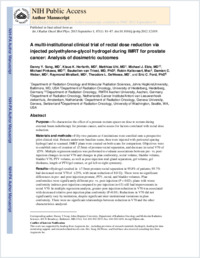A multi-institutional clinical trial of rectal dose reduction via injected polyethylene-glycol hydrogel during IMRT for prostate cancer: Analysis of dosimetric outcomes.
- Song, Danny Y. Johns Hopkins School of Medicine, Baltimore, MD
- Herfarth, Klaus Department of Radiooncology, University of Heidelberg, Heidelberg, Germany
- Uhl, Matthias Department of Radiooncology, University of Heidelberg, Heidelberg, Germany
- Eble, Michael J. Rheinisch-Westfaelische Technische Hochschule Aachen, Aachen, Germany
- Pinkawa, Michael Rheinisch-Westfaelische Technische Hochschule Aachen, Aachen, Germany
- Van Triest, Baukelien Netherlands Cancer Institute, Amsterdam, Netherlands
- Kalisvaart, Robin Netherlands Cancer Institute/Antoni van Leeuwenhoek ziekenhuis, Amsterdam, Netherlands
- Weber, Damien C. Geneva University Hospital, Department of Radiation Oncology and Centre de Recherche Clinique Dubois Ferrière Dinu Lipati, Geneva, Switzerland
- Miralbell, Raymond Geneva University, Geneva, Switzerland
- DeWeese, Theodore L. Johns Hopkins University School of Medicine, Baltimore, MD
- Ford, Eric University of Washington Medical Center, Seattle, WA
Published in:
- Journal of Clinical Oncology. - American Society of Clinical Oncology (ASCO). - 2013, vol. 31, no. 6_suppl, p. 35-35
English
35 Background: To characterize the effect of a prostate-rectum spacer on dose to rectum during external beam radiotherapy for prostate cancer, and to assess for factors correlated with rectal dose reduction. Methods: Fifty-two patients at 4 institutions were enrolled onto a prospective pilot clinical trial. Patients underwent baseline scans, then were injected with perirectal spacing hydrogel and re-scanned. IMRT plans were created on both scans for comparison. Objectives were to establish rates of creation of ≥7.5mm of prostate-rectal separation, and decrease in rectal V70 of ≥25%. Multiple regression analysis was performed to evaluate associations between pre- vs. post-injection changes in rectal V70 and changes in plan conformity, rectal volume, bladder volume, bladder V70, PTV volume, as well as post-injection mid-gland separation, gel volume, gel thickness, length of PTV/gel contact, or gel left-to-right symmetry. Results: Hydrogel resulted in > 7.5mm prostate-rectal separation in 95.8% of patients; 95.7% had decreased rectal V70 of > 25%, with mean reduction of 8.0 Gy. There were no significant differences in pre- and post-injection prostate, PTV, rectal, and bladder volumes. Plan conformities were significantly different pre- vs. post-injection (P = 0.02). In multiple regression analysis, change in plan conformity was negatively associated with reduction in V70 (P=0.01); plans with worse conformity indexes post-injection compared to pre-injection (n=13) still had improvements in rectal V70. Reductions in V70 did not significantly vary by institution, despite significant inter-institutional variations in plan conformity. There were no significant relationships between reduction in V70 and the other characteristics analyzed. Conclusions: Injection of hydrogel into prostate-rectal interface resulted in dose reductions to rectum for > 90% of patients treated. Rectal sparing was statistically significant across a range of 10-75 Gy, and was demonstrated within the presence of significant inter-institutional variability in plan conformity, target definitions, and injection results.
- Language
-
- English
- Open access status
- green
- Identifiers
-
- DOI 10.1200/jco.2013.31.6_suppl.35
- ISSN 0732-183X
- Persistent URL
- https://folia.unifr.ch/global/documents/161289
Statistics
Document views: 13
File downloads:
- fulltext.pdf: 0
